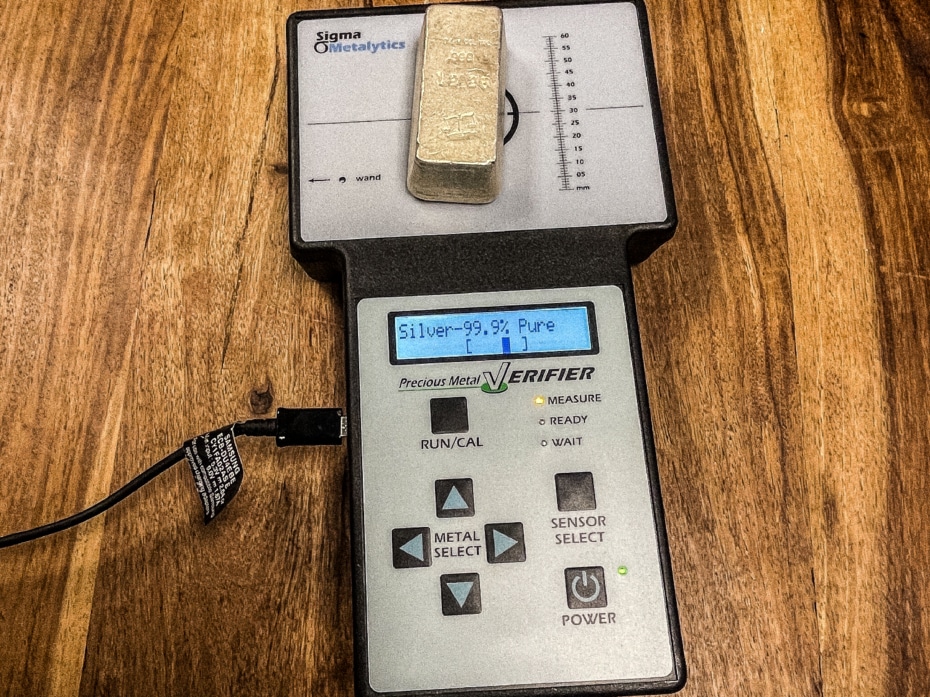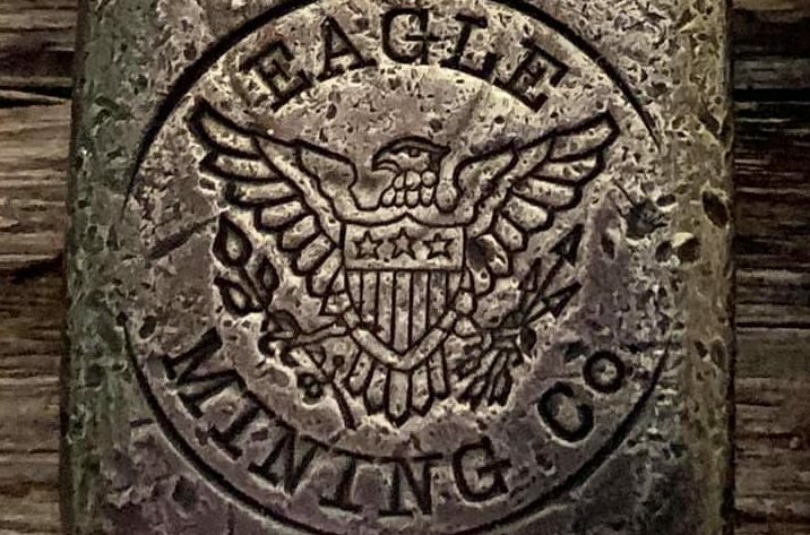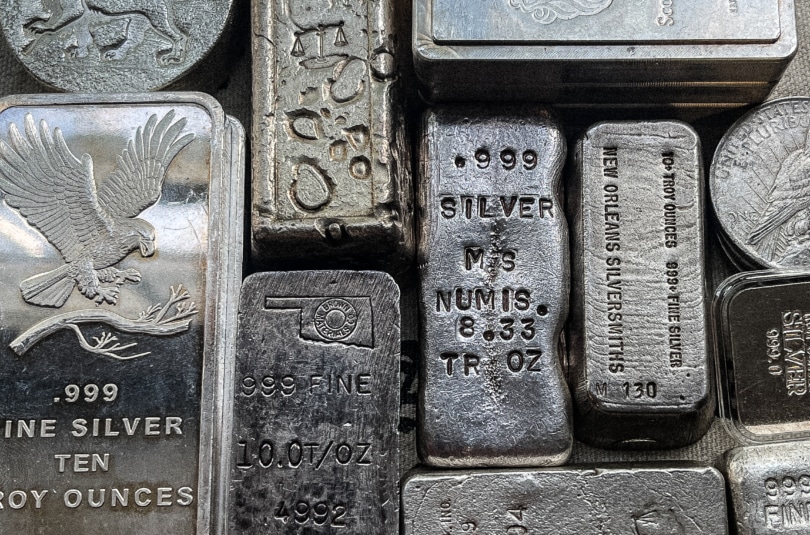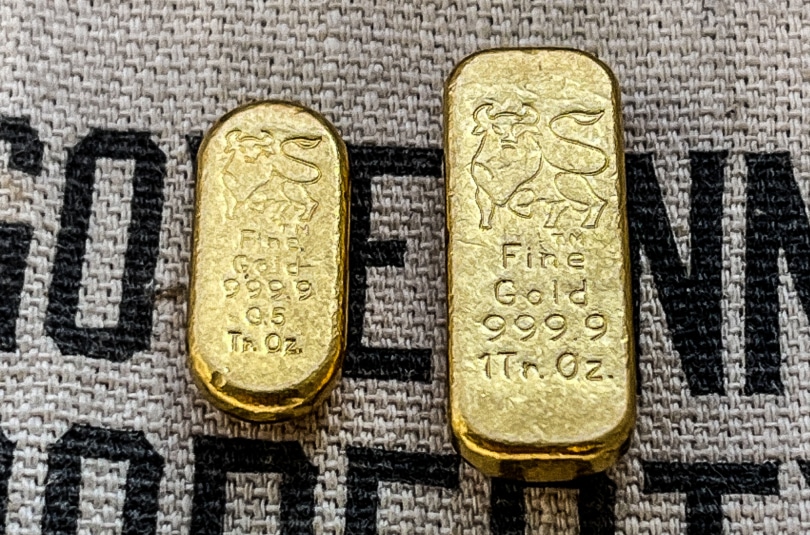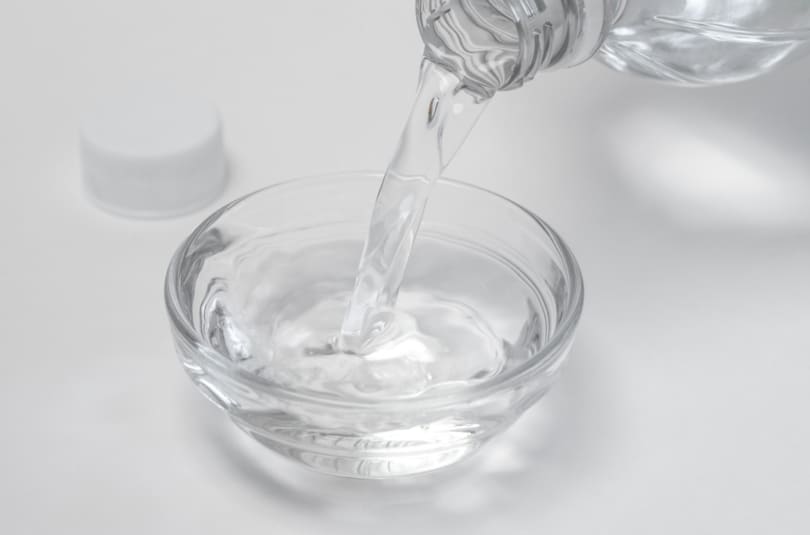Even though silver is not as valuable as gold, this shiny precious metal attracts plenty of attention from investors, collectors, and enthusiasts worldwide. After all, silver has been a sought-after commodity for centuries, facilitating money exchange and trading activities.
However, only some silver pieces you encounter will feature authentic precious metal, with around 90% of family heirlooms arriving at pawn shops failing to meet silver purity standards.
In other words, fake silver is more common than you might think, and the same applies to silver bars. For that reason, distinguishing real silver from fake is essential, and that’s why we listed the best techniques for testing silver bars and coins.
What Is ‘Real’ Silver?
As you probably know, pure silver is a soft and malleable precious metal. Thus, most silver items in households are not 100% pure, featuring other metals like copper, nickel, or zinc to increase the product’s firmness.
For instance, sterling silver comprises 92.5% silver and 7.5% nickel or copper. Likewise, American silver coins have around 89.2% purity, while investment-grade silver typically features the famous three nines fineness (99.9%).
Most experts agree that everything above 80% of silver content classifies as actual silver. On the other hand, fake silver bars, coins, and jewelry are, in most cases, silver-plated. In translation, they feature a thin layer of silver with a low-value interior.
Alternatively, various shiny alloys can look like silver to the untrained eye, fooling gullible investors and causing expensive mistakes.
Why Should You Test Silver?
If you are serious about collecting silver bars and building a respectable collection, learning how to test silver is a must. Otherwise, you’ll be out of the game before you know it. Fake silver and counterfeited items will dry out any budget.
So, the primary reason for testing silver is to separate fake pieces from real ones. Whether buying or selling silver, mastering some of the techniques we’ll explain below is essential.
Financial aspects don’t have to be the only motivation for verifying silver’s authenticity and purity. For example, silver can trigger adverse reactions in people with allergies or sensitive skin. Hence, knowing whether they are handling real or fake silver could prevent various issues.
How To Avoid Buying Fake Silver?
The time-tested saying that knowledge is power applies to collecting silver bars and investing in precious metals. So, learning and researching is the first step toward reducing the chances of buying fake silver.
For instance, reading about the methods for testing silver is a great start. Consequently, the next level would be to apply these procedures and test silver bars before splashing the cash.
The Best Methods for Testing Silver:
Leaving no stone unturned is the best approach, and that’s why experienced investors and enthusiasts combine several methods to authenticate silver bars. You can perform some of these activities at home, while others require more elaborate equipment. Also, some are more accurate and reliable than others.
Nevertheless, knowing more about various approaches could be beneficial. So, it’s time to see the most-used ways to test silver and avoid buying fakes.
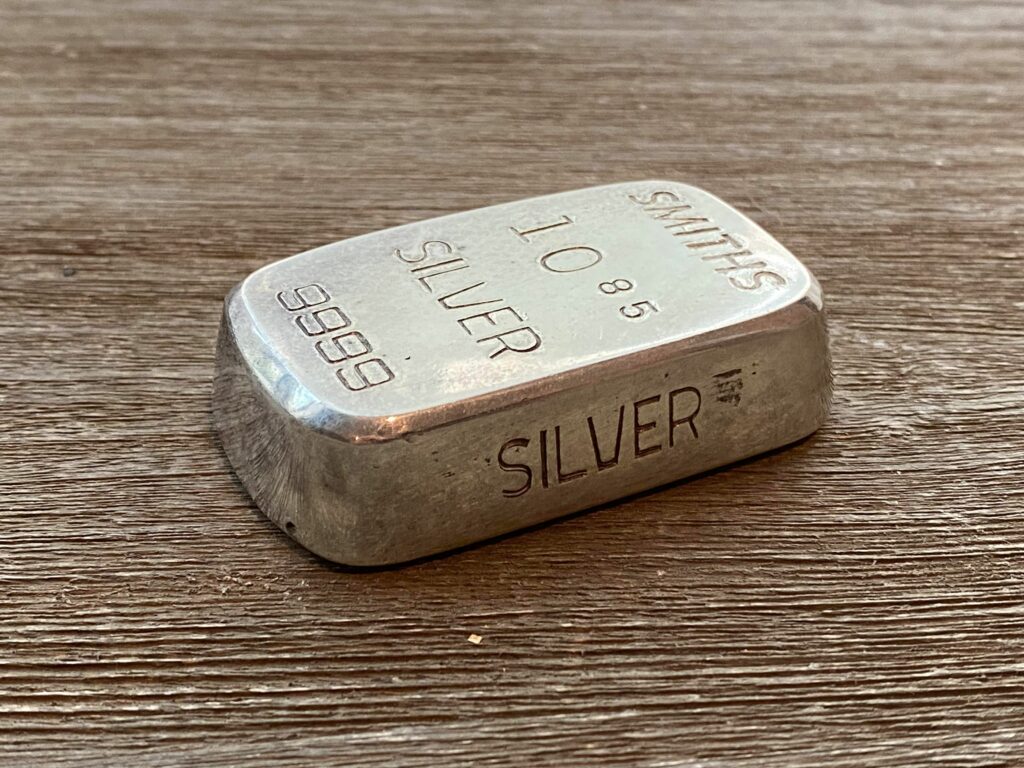
– The Eye Test
The first technique to categorize vintage silver bars is not the most rookie-friendly because it requires a trained eye and years of experience. However, visual inspection is the basis for building your collection, so the sooner you develop the skills, the better.
Namely, aspiring collectors should check for discolorations and tarnishing because genuine silver with 99.9% purity doesn’t darken quickly. Of course, we are not saying that real silver doesn’t turn black, only that high-value vintage silver bars should be well-kept and polished.
Since we mentioned polishing, we should add that the “eye test” involves checking the shine and luster of a silver bar. After all, fake silver will look dull and less attractive than authentic pieces. Then again, we recommend caution because skilled forgers can replicate the shine with various alloys and polish them to perfection.
In conclusion, visual inspection is the starting point, not the conclusive testing method, so let’s check the others.
– The Weight Test
Silver bars and coins adhere to several rules and regulations, including specific weight, shape, and size. On top of that, silver enthusiasts use particular terminology, such as troy ounce, a traditional measurement for precious metals.
If you are new to the world of gems and precious metals, you might forget that one troy ounce is around 10% heavier than the standard ounce, weighing approximately 31.10 grams. The differences between these units can overwhelm and confuse less experienced investors, allowing shady players to sell fake silver and collect high premiums.
Therefore, always weigh the pieces to see if the weight matches the specifications and documented values. Of course, anything above or below the specified values is a red flag, signaling you’re dealing with counterfeit silver bars.
Silver has a much higher density than steel, copper, zinc, or brass alloys, making it challenging to get the weight right when forging silver bars.
– The Odor Test
Silver has captured people’s hearts and minds for centuries with its distinctive qualities, and being odorless is among them. In other words, silver doesn’t have a specific smell like many other elements have.
For instance, fake silver bars made of steel will have a metallic fragrance, so watch out for these pieces. Silver-plated items will also have a noticeable scent, despite the thin layer of silver covering other metals. In addition, higher contents of sulfur in the tarnish will leave a noticeable odor.
Admittedly, this method for testing silver also requires plenty of experience, alongside a strong sense of smell. Then again, the key is to remember that silver is odorless and that any noticeable scents could be signs of nefarious activities.
– The Vinegar Test
If you need a convenient method to test silver pieces at home, vinegar could be right up your street. After all, this acidic liquid is a household staple, readily available in almost any store. On top of that, the vinegar test is safer than other acid tests we’ll mention later.
The word vinegar comes from the French “vin aigre,” meaning sour wine, and the term accurately describes the liquid’s nature. The sourness comes from acetic acid, with most domestic brands having between 5% and 10% acidic content.
So, how to test silver with vinegar, and should you do it in the first place? Even though vinegar can double as a silver cleaner, this aqueous solution will help detect real silver because it also boosts oxidization, turning the silver item black after 48 hours.
The downside to testing silver with vinegar is that you have to wait for silver to tarnish, making this method unsuitable for collectors who need results on the spot. Hence, the following technique could better fit most silver enthusiasts.
– The Ice Test
Frozen water is another item you’ll find in almost any household, making it an inexpensive option for testing silver and distinguishing fake from real. However, many are unfamiliar with the ice test, or they doubt its accuracy and reliability.
Namely, the secret lies in silver’s excellent thermal conductivity. So, an ice cube placed on top of a vintage silver bar will melt much faster than another ice cube placed on copper or iron. Of course, you can also use fake and real silver coins to compare the results.
Since silver conducts heat better than most metals, the ice cube will melt noticeably faster on items with higher contents of silver. This approach to testing silver requires two or three pieces for comparison, which shouldn’t be an issue for collectors and precious metals enthusiasts.
However, the ice test leaves room for subjective interpretations of how the ice melts and whether silver is real or fake. Therefore, this approach works best when combined with other methods for testing silver.
– The Magnet Test
Magnets and precious metals rarely see eye to eye, i.e., the magnetic force shouldn’t move your favorite gold necklace or silver bracelet. If the piece leaps toward the magnet, your partner will have some explaining to do.
So, since silver is non-magnetic and has a ferromagnetic core, an authentic silver bar should stay immune to the magnet’s gravitational pull. Hence, most collectors and investors in precious metals should have a powerful magnet within reach when shopping for vintage silver bars.
The recommended option would be a rare earth Neodymium magnet because these pocket-friendly units deliver the best performance. For silver bars, the test involves tilting the silver at 45 degrees and placing the magnet near the top to allow it to slide down.
With fake silver and silver-plated pieces, the magnetic field will keep the magnet in place. On the other hand, Neodymium magnets should slowly slide down the bar made from fine silver.
– The Sound Test
The following approach to testing silver shares similarities with the eye test we mentioned earlier, given that you need experience and knowledge to distinguish real silver from fake. Nevertheless, the ring or sound test is among the most popular methods for separating forgeries from authentic pieces.
In addition, the sound test has been around for decades, primarily used on silver coins. Of course, the rules also apply to vintage silver bars, and savvy investors often revert to this technique before buying silver.
Silver items should produce a high-pitched, bell-like sound with a few milliseconds of echo when tapped on with another metallic object. On the other hand, fake silver generates a dull sound with no echo.
So, tap a silver bar with a coin. A clear, high-pitched ringing is what you want to hear, while a dull thump translates to a big no-no. Alternatively, dropping the piece from around six inches should produce the same audio. The gist of the sound test remains the same, regardless of the technique.
– The Acid Test
We mentioned acids when explaining how to test silver with vinegar, and now we should elaborate on the topic. After all, some of the best silver testing kits in 2022 focus on the silver’s reactivity to acidic components. Thus, aspiring collectors should familiarize themselves with this approach to testing silver bars and coins.
Namely, the acid test translates to a chemical analysis, but you don’t need a degree in chemistry to understand the results. In addition, most silver-testing kids have detailed instructions and color schemes for effortless usage.
Real silver will react to various acids and color the acidic component. Thus, the test requires rubbing the silver bar against a testing stone or a file to reach the core. Then, you’ll drop the acid on the incision and check the color scheme. In most cases, reddish brown suggests sterling silver (.925), while dark red shows the highest purity.
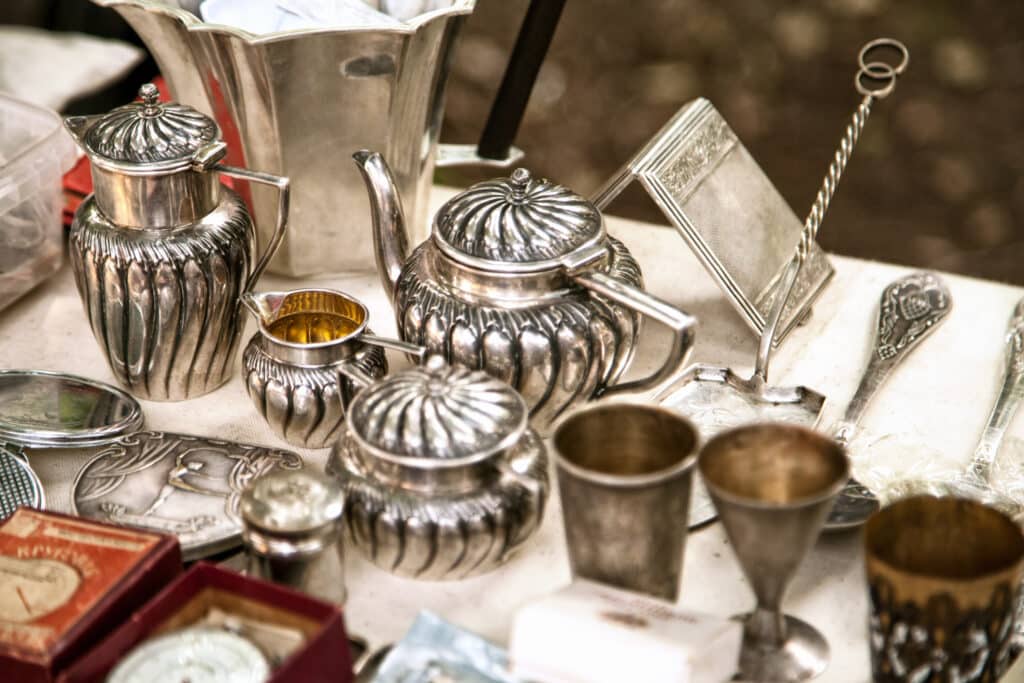
– The Polishing Test
Antique silver pieces typically feature discoloration because this precious metal has a famous Achilles’ heel—oxidation. Silver reacts with sulfur from the air and gradually turns black, especially if exposed to high humidity or light. When the discoloration looks unattractive, we call it tarnishing; otherwise, we refer to it as toning.
For centuries, people struggled with tarnished silver and spent hours polishing silverware. When you remove the sulfur sulfide from the surface, a silver piece’s natural shine and luster will appear again. So, we can copy this procedure to test vintage silver bars and verify their authenticity.
First, grab a clean, extra-soft white cloth and rub the silver piece. Of course, be careful with the markings and engravings but apply enough pressure to remove any residue. More precisely, investment-worthy silver bars will leave a trace on the cloth because real silver turns black when exposed to air.
This method might remove tiny pieces of silver from the surface, but the risk of damaging the silver bar is almost zero. Unfortunately, this is not the case with most ways of testing silver.
– The Flake Test
For instance, the following method is more aggressive and causes permanent damage to fake silver pieces. Luckily, silver-plated or counterfeit silver items have no numismatic value, so the flake test goes on the list as one of the ways to test silver in 2022.
So, what do we mean by an aggressive approach, and can vintage silver bars even flake?! Well, a real silver bar will pass this test with flying colors, but silver-plated items might struggle.
Wear and tear will leave scars on the surface of these items, and scratching the surface will remove the flakes to reveal the material below. So, cutting corners and opting for an extra thin layer of precious metal when creating silver-plated items can be a double-edged sword.
Moreover, you can take the flakes and use a silver-testing kit to double-check the findings. However, combining these methods requires more time and equipment than you’ll probably have when buying silver bars from dealers or collectors. That’s where the following technique for testing silver steps onto the scene.
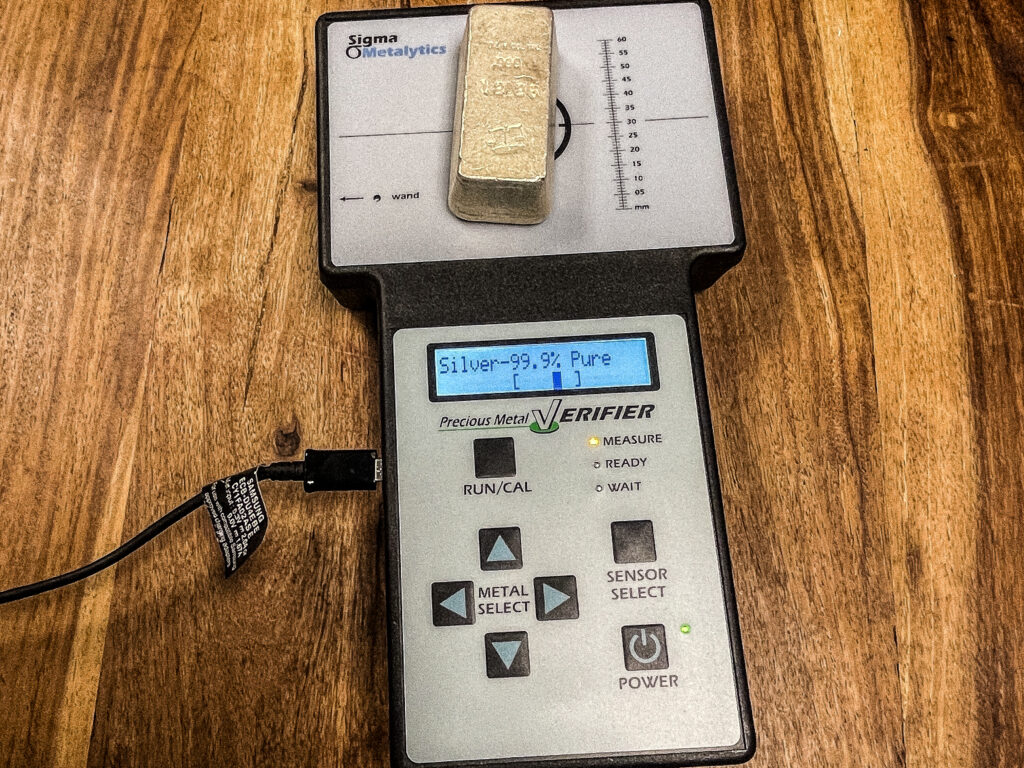
– Using the Sigma
We use various devices to make our lives more comfortable, and precious metal verifiers are among those devices. Even though these units are niche products, every self-respecting silver dealer should have one within reach. The famous Sigma XRF analyzer is a safe bet, although these high-tech gadgets can cost an arm and a leg.
The XRF comes from X-ray fluorescence, indicating that precious metal verifiers perform surface readings to determine metal contents. Best of all, the X-ray sensors go through entire samples (up to 45 mm thick), eliminating the chances of hiding counterfeit inserts in the core of an alleged vintage silver bar.
The technology behind this method for testing silver might be next-gen, but Sigma handheld analyzers are straightforward and user-friendly. The readings will reveal the metallic contents with top-tier accuracy, which is why this way of testing silver is unbeaten regarding reliability. Yet, the hefty price tag makes buying a Sigma only necessary if you are a full-time collector, investor, or dealer.
– Checking the Label
Finally, we came to the last entry on the list of the best ways to test silver and avoid buying fake silver bars. In a way, this final method expands the approach explained in the first method of this guide but raises the bar to the next level.
More precisely, we are talking about the markings and engravings on vintage silver bars, also known as hallmarks. These logos and numbers serve as reference points for collectors and enthusiasts, with every silversmith adding these elements as the pieces leave the furnace.
Admittedly, skilled forgers could mimic the original hallmarks and fool even the most experienced silver dealers. However, many fake silver bars come with easy-to-spot errors or imperfections around the engravings. So, use these as tell-tell signs of counterfeiting, and double-check the pieces before adding them to your silver bars collection.
Final Thoughts on Testing Silver
And there you have them; a comprehensive set of approaches and procedures to separate real silver from fake. The methods we listed offer varying accuracy, and experts recommend combining a couple of them to get the highest reliability.
In any case, these silver testing methods will help you detect worthless pieces from investment-worthy items. In addition, getting some hands-on experience with testing silver for purity and authenticity will expand your understanding of this precious metal.
